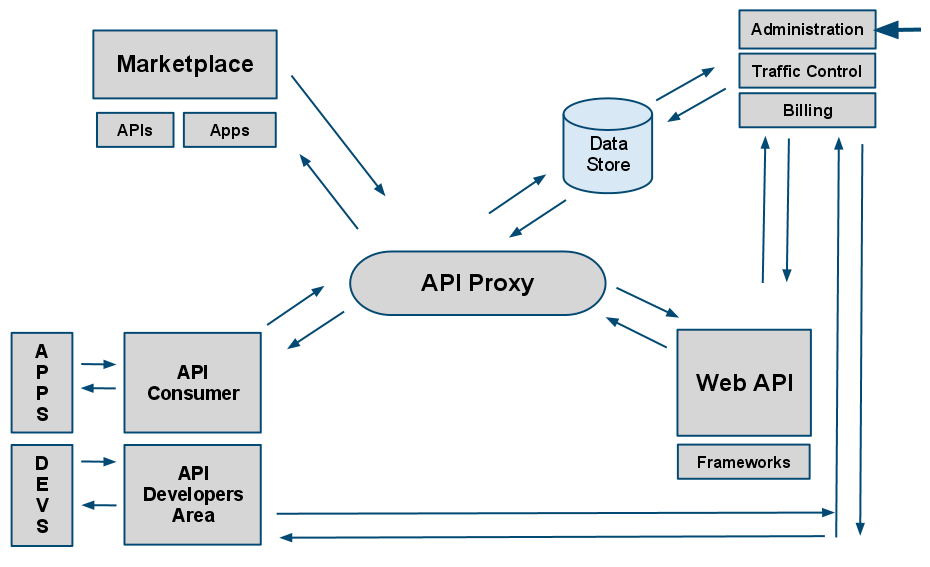
I'm working through some 100K views of the API service provider arena, and trying to evolve my perspectives of
Whats Next for APIs.
This is all a work in progress, so I'm publishing here on
kinlane.com instead of on
apievangelist.com.
I wrote the other day about the
Battle for Your API Proxy between the API service providers.
This included a tier of "proxy" API skinlane-productions2at run all your APIs through proxy before hitting your API.

Next there are the group of "connector" API service providers that provide you with a connector to put in your API and provide the same services that a proxy would.

Based upon what I'm seeing with Mashape and other indicators, I tried to show the playing field in a slightly different, and evolved way.

My vision of the future of APIs involves several key areas of evolution. These are based upon movements I'm already seeing, and where I'd like to see things go.
In this vision API service providers don't just provide proxy, connector, management, developer area tools, and API marketplaces. They also provide actual API frameworks for APIs like Mashape provides, as well industry wide developer opportunities.
Developers can build code against a single API, or multiple APIs, they can build tools for API owners to deploy in their own management, developer areas as well as within the "proxy" or "connector" layer too. Service providers will provide developers with distribution opportunities to other marketplaces and API owners.
API Owners will not be locked into a single API service provider for their API, Management, Proxy, Connector, Developer or Marketplace needs. They will have a buffet of add-ons they can choose from to enhance every aspect of their API ecosystem.
One key difference is that API owners can choose to proxy or connect their API, or both if necessary for different services.
This model provide sadd-ons at every layer of the API ecosystem. If a developer builds a set of tools for video streaming, it can be deployed at the proxy / connector, management, API, and developers area. Billing for a video API might look radically different then billing for a print API.
This will provide the type of innovation that is needed at this stage of the game. A nice selection of tools for API owners to choose from, with service provider and developers making money.
Related articles

 Next there are the group of "connector" API service providers that provide you with a connector to put in your API and provide the same services that a proxy would.
Next there are the group of "connector" API service providers that provide you with a connector to put in your API and provide the same services that a proxy would.
 My vision of the future of APIs involves several key areas of evolution. These are based upon movements I'm already seeing, and where I'd like to see things go.
In this vision API service providers don't just provide proxy, connector, management, developer area tools, and API marketplaces. They also provide actual API frameworks for APIs like Mashape provides, as well industry wide developer opportunities.
Developers can build code against a single API, or multiple APIs, they can build tools for API owners to deploy in their own management, developer areas as well as within the "proxy" or "connector" layer too. Service providers will provide developers with distribution opportunities to other marketplaces and API owners.
API Owners will not be locked into a single API service provider for their API, Management, Proxy, Connector, Developer or Marketplace needs. They will have a buffet of add-ons they can choose from to enhance every aspect of their API ecosystem.
One key difference is that API owners can choose to proxy or connect their API, or both if necessary for different services.
This model provide sadd-ons at every layer of the API ecosystem. If a developer builds a set of tools for video streaming, it can be deployed at the proxy / connector, management, API, and developers area. Billing for a video API might look radically different then billing for a print API.
This will provide the type of innovation that is needed at this stage of the game. A nice selection of tools for API owners to choose from, with service provider and developers making money.
Related articles
My vision of the future of APIs involves several key areas of evolution. These are based upon movements I'm already seeing, and where I'd like to see things go.
In this vision API service providers don't just provide proxy, connector, management, developer area tools, and API marketplaces. They also provide actual API frameworks for APIs like Mashape provides, as well industry wide developer opportunities.
Developers can build code against a single API, or multiple APIs, they can build tools for API owners to deploy in their own management, developer areas as well as within the "proxy" or "connector" layer too. Service providers will provide developers with distribution opportunities to other marketplaces and API owners.
API Owners will not be locked into a single API service provider for their API, Management, Proxy, Connector, Developer or Marketplace needs. They will have a buffet of add-ons they can choose from to enhance every aspect of their API ecosystem.
One key difference is that API owners can choose to proxy or connect their API, or both if necessary for different services.
This model provide sadd-ons at every layer of the API ecosystem. If a developer builds a set of tools for video streaming, it can be deployed at the proxy / connector, management, API, and developers area. Billing for a video API might look radically different then billing for a print API.
This will provide the type of innovation that is needed at this stage of the game. A nice selection of tools for API owners to choose from, with service provider and developers making money.
Related articles
